Bleaching teeth to get them white has become increasingly popular. Today's Dental Bleaching agents are safer and more effective than previous agents. In general Dental bleaching is a very safe, inexpensive, and effective cosmetic treatment.
People, however, are often dissatisfied with the results of Dental bleaching. The reason for this is that they have unrealistic expectations. Many expect their teeth to be as white as copy paper after the procedure. Even at their whitest, however, your teeth can not approach this degree of whiteness. Its just not the way nature made teeth to look!
The best rule of thumb is that the whitest your teeth can possibly become is as white as the whites of your eyes!
For people who have really yellow teeth what you can expect is a result that is about two shades whiter than what you have now. Even with the most sophisticated Dental bleaching systems, there is a variability in results - 3 shades whiter to no change at all. As this is a cosmetic procedure, the Dental Bleaching service cannot guarantee you a specific result.
How long does the Dental bleaching last? We like to compare bleaching to a face lift. Even the best face lifts deteriorate with time but you still look better 10 years later than if you didn't have one in the first place.
What cosmetic surgery and Dental bleaching have in common is that they take off the perception of aging and take years off your appearance. Typically bleaching can last 10 years depending on whether or not you smoke, consume acid containing foods, or consume staining foods like red wines and coffee. Even though bleaching can fade, it still delays the eventual darkening that happens to us all.
Some people have tooth colored fillings in their teeth that match their yellow teeth before the Dental bleaching. After the Dental bleaching, the teeth whiten but the fillings stay the same color. Consequently, these fillings will need to be replaced at an extra cost after the Dental bleaching is completed.
Additionally, crowns or porcelain restorations in conspicuous areas will not lighten from bleaching and may not match the shade of your newly bleached teeth.
Another word of caution - those people with sensitive teeth should avoid bleaching procedures. teeth whitening could increase the sensitivity of your teeth. Some people even experience extreme pain. If you have sensitive teeth but would still like to bleach your teeth, we suggest that you first correct the sensitivity problem.
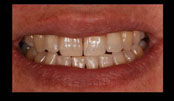
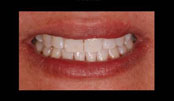
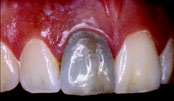
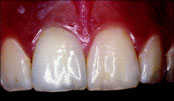
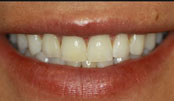
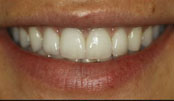
Porcelain Veneers are a beautiful way to correct stained, chipped, or crooked teeth. By placing glass-like ceramic porcelain on the surface of teeth, dentists can provide patients with bright, straight, and natural looking smiles. If you are considering veneers but would like more information about the process of placing porcelain veneers and the cost of treatment, please read the information below.
Porcelain veneers are thin shells of porcelain that are bonded onto the front side of teeth to create a cosmetic improvement for a tooth. They are routinely used as a way to make cosmetic changes for teeth that are discolored, worn, chipped, or misaligned.
Porcelain veneers have a great advantage over other cosmetic bonding techniques because they are translucent and when bonded onto a tooth's surface they will closely mimic the light handling characteristics of dental enamel. Dental crowns typically encase an entire tooth whereas porcelain veneers only cover over the front side of a tooth.
In comparison to a dental crown, the classic porcelain veneer is a wafer thin shell of ceramic that is bonded onto the front side of a tooth. Whereas a dental crown covers over and encases the entire tooth, a Porcelain Veneers just covers over the side of the tooth that shows when the person smiles. Dental crowns and porcelain veneers also differ by way of their relative thickness. The classic porcelain veneer will measure 1 millimeter in thickness or less, as opposed to a dental crown that typically measures 2mm. Here are some of the factors determine which type of dental restoration would be the more ideal choice.




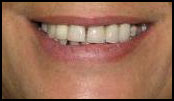

The loss of a single tooth can have a major impact on your dental health and personal appearance. Your teeth support and rely on each other. When one or more teeth are missing, the remaining teeth can shift out of their normal position. Teeth adjacent to the space or from the opposite jaw will often drift or tilt. These teeth are often more susceptible to decay and gum disease because they are more difficult to clean around. All of this shifting and drifting will lead to changes in the bite, which may put stress on the jaws, muscles and teeth. Ultimately, your ability to chew comfortably and your appearance may be affected.
If tooth loss occurs, your dentist may recommend that a bridge be placed. A bridge consists of a replacement tooth/teeth attached to crowns on each side. The bridge is cemented to the teeth adjacent to the space, effectively replacing the missing tooth and preventing any shifting.
The procedures involved in making a bridge are very similar to those for making a crown. Bridges can be made from the same materials as crowns - full porcelain, porcelain fused-to-metal, and all metal. At least two appointments are necessary. At the first visit, your dentist will prepare the teeth next to the missing tooth for crowns. An impression of the prepared teeth will be made and a temporary bridge will be placed. At the subsequent visit, your dentist will fit and adjust the bridge and then cement it in place.
Your new bridge will require some special care when brushing and flossing. Your dental professional will instruct you how to clean around and under the bridge. They may recommend various cleaning aids to help you keep the plaque off and prevent further decay and gum disease.






In the past, teeth were most commonly repaired with dental amalgam replacement(silver) fillings or gold restorations. Thanks to advances in modern dental materials and techniques, teeth can be restored with a more aesthetic and natural appearance. There are different types of cosmetic fillings currently available. The type used will depend on the location of the tooth and the amount of tooth structure that needs to be repaired.
The most simple form of white filling is technically called a Composite. It is made up of a composite quartz resin and usually contains some sort of light sensitive agent. These light cured composites are extremely cosmetic and most often bonded into place in one appointment. For this reason, they are often referred to as "bonding". They can be used in both the front of the mouth as well as in your back teeth. These materials come in a variety of shades so that they will match the color of your own teeth. Some of these composite materials have been specifically designed to actually withstand the incredible forces you can exert when chewing on your back teeth.
In order to bond a white filling material to your tooth it is first necessary to remove decay, prepare the tooth and then to condition the enamel and dentin. Once conditioned, a thin resin is applied which bonds to the etched surface. The bond strength of these white fillings is incredible. Today we can bond plastics and even dental amalgam (silver fillings) to your teeth. Bonding increases the strength of these restorations far beyond those of only a short time ago.
After placement, composites are hardened by shining an intense light on them for a specified period of time, usually around 40 seconds.
The other type of white filling is called a Composite or Porcelain Inlay. These fillings are usually placed in back teeth when esthetics is of utmost concern. In order to increase their strength and longevity, they are fabricated in the laboratory and then bonded into position in the office. This is a two visit procedure rather than the one visit required to place a composite filling. However, when it comes to strength and cosmetics, the extra time and expense is well worth it.



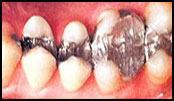
Bonding is the application of a tooth-colored composite resin (plastic) to repair a decayed, chipped, fractured or discolored tooth.
Unlike veneers, which are manufactured in a laboratory and require a customized mold to achieve a proper fit, bonding can be done in a single visit. The procedure is called bonding because the material bonds to the tooth.
Bonding is among the easiest and least expensive of cosmetic dental procedures.
The composite resin used in bonding can be shaped and polished to match the surrounding teeth. Most often, bonding is used for cosmetic purposes to improve the appearance of a discolored or chipped tooth.
It also can be used to close spaces between teeth, to make teeth look longer or to change the shape or color of teeth.
Sometimes, bonding also is used as a cosmetic alternative to amalgam fillings, or to protect a portion of the tooth's root that has been exposed when gums recede.






Tooth jewellery is a brilliant way to add sparkles to your smile and stand out of the crowd.
Tooth jewellery is the latest thing in cosmetic dentistry - and it's popular with people of all ages.
Surprise your friends with a sparkling crystal glass design, or something in gold with a twinkle of ruby or diamond.
These tiny little designs are great fun, and because there's no drilling involved, they won't harm your teeth . und and under the bridge. They may recommend various cleaning aids to help you keep the plaque off and prevent further decay and gum disease.
At Dental Renaissance, we're committed to maintaining the health of your teeth. The tooth jewellery we use and the procedures for applying it have been tried and tested, so you can wear our tooth jewellery with confidence.
The procedure is very simple. Just like an orthodontic bracket, the design is bonded onto your teeth.
It's easy to change or remove and usually takes about 10 to 15 minutes.


